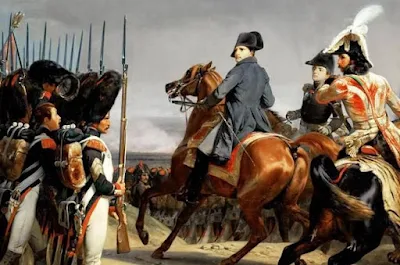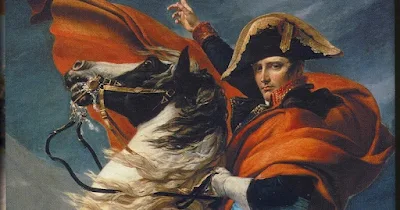Napoleon's strategies in 7 points
Napoleon Bonaparte was one of the greatest generals in history, who used various tactics to conquer Europe and expand the First French Empire.
 |
| Napoleon's strategies in 7 points |
These are some of their most notable strategies:
1. The tactics of the army corps
Napoleon concentrated his forces in large bodies of about 20,000 men, which he could move rapidly around the battlefield as necessary to reinforce weak points or take advantage of opportunities created by the enemy.
The Army Corps' tactics consisted of grouping troops into large, flexible units that could maneuver quickly and autonomously on the ground. Napoleon used this tactic to surprise the enemy, attack his flanks or rear, or break his line of battle. Some examples of this tactic are the battles of Austerlitz, Jena and Wagram, where Napoleon managed to defeat armies superior in number and organization thanks to the mobility and coordination of his army corps.
2. The tactic of concentration of forces
Napoleon believed that the key to victory was to concentrate forces at a specific point on the battlefield, which allowed for maximum impact. This tactic was often combined with surprise attacks and mobility to gain an advantage over the enemy.
The tactic of concentration of forces consists of gathering the largest possible number of troops and resources in a strategic location on the ground, in order to achieve local superiority over the enemy and break their defense lines. This tactic was successfully used by Napoleon Bonaparte in several of his military campaigns, such as the Battle of Austerlitz or the Battle of Jena.
Napoleon believed that the key to victory was to concentrate forces at a specific point on the battlefield, which would allow for maximum impact and demoralize the adversary. To do this, he used a series of maneuvers and deceptions that allowed him to hide his intentions and movements from the enemy, as well as take advantage of the terrain and weather conditions.
The tactic of concentration of forces requires great coordination and speed of action, as well as good intelligence and communication. It also involves taking certain risks, such as leaving flanks or supply lines exposed, or losing the initiative if the enemy anticipates or resists the attack.
3. The blitzkrieg tactic
4. The tactic of the strategic reserve
Napoleon reserved a part of his troops to intervene at the decisive moment of the battle, when the enemy was weakened or in disarray. This tactic allowed him to change the course of many battles and achieve overwhelming victories.
One of the keys to Napoleon Bonaparte's military success was his ability to use the strategic reserve in his campaigns. This consisted of keeping a part of his troops out of the initial combat, hidden or in the rear, and then launching them into the attack at the most opportune moment. Thus, Napoleon could surprise the enemy, break his line of defense, exploit his weaknesses or prevent his retreat. The strategic reserve allowed Napoleon to win decisive battles such as Austerlitz, Jena or Friedland, where his fresh and motivated troops made the difference against an exhausted and demoralized enemy.
5. The tactic of the enveloping maneuver
Napoleon sought to surround the enemy on both flanks, cutting off his lines of communication and supply, and forcing him to surrender or fight under unfavorable conditions. This tactic allowed him to capture thousands of prisoners and enemy weapons.
One of Napoleon's most successful strategies on the battlefield was the enveloping maneuver, which consisted of attacking the enemy from both sides with two columns of soldiers, while a third column remained in the center to distract and contain the adversary. In this way, Napoleon managed to surround the enemy and cut off his means of escape, communication and supply, which left him in a critical and vulnerable situation. The enveloping maneuver allowed Napoleon to win numerous victories and weaken the morale and resistance of his opponents.
6. The hollow center tactic
Napoleon weakened the center of his line to strengthen the flanks, giving the enemy the impression that he could easily break their line. When the enemy advanced towards the center, Napoleon attacked him from the flanks with his reserves and annihilated him.
One of Napoleon's most ingenious strategies was the hollow center. It consisted of weakening the center of their formation and strengthening the flanks, creating an illusion of vulnerability. The enemy, confident of being able to break the French line, rushed towards the center with all their forces. Napoleon then deployed his hidden reserves and attacked the unsuspecting enemy from the flanks, surrounding and destroying them.
7. The tactic of the moral blow
Napoleon rushed to conquer the capital of the rival nations, thus dealing a moral blow. This tactic allowed him to intimidate his opponents and gain the support of his allies.
The tactic of the moral blow was one of the keys to Napoleon Bonaparte's military strategy, which consisted of quickly attacking the enemy's capital to cause their surrender or demoralization. Napoleon applied this tactic on several occasions, such as in the campaigns of Italy, Austria, Prussia and Russia, always seeking the decisive victory that would allow him to impose his political conditions.
Furthermore, Napoleon reinforced his moral blow with the construction of monuments that symbolized his power and glory, such as the column in the Place Vendôme in Paris, erected with cannons captured from the Austrians in the Battle of Austerlitz.






Comments
Post a Comment